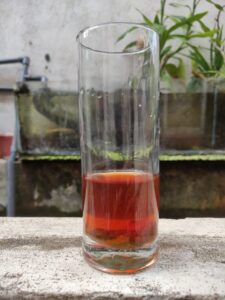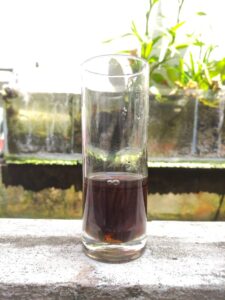Often, blackwater-style aquariums are designed to mimic nature. All the dry leaf litter, bunches of twigs, driftwoods together with tannin acids and humic substances, botanical-style aquariums can give you a calming feeling all day long. Slow-moving natural water streams flooded water beds and small ponds with stagnant waters are the ideal natural habitats where you can observe this kind of darker waters. To enjoy botanical-style tank setups, you may have to think out of the box and appreciate what you are seeing as the ecosystem and nature takes time to settle down. In botanical style setups, aquascapers embrace biofilms, fungal growths, decomposition, turbidity, and darker colors. Overall, if you can make the necessary mental shifts, you can enjoy this unique style of tank setup.
Along with disease resistance, enhanced colors, and physical health, your fish can have a very vast diet as well. Having a variety of feed can improve the overall health of your fish. It can improve your fish life expectancy and your fish can even spawn. And finally, to bust a misconception among hobbyists, just because your tank water is darker, does not mean it is dirty.
Leaf litter and botanical items are often used.
Locally available, twigs, stones, and dry leaves can be used in blackwater setups. Adding locally collected leaves can give you a vast idea about the selected leaves’ tannin percentages, decay rates, and color composition. Avoid stone types that do not affect the water hardness or alkalinity when selecting stones.
- Indian almond leaves. (Terminalia catappa leaves)
- Mango leaves.
- Jack fruit leaves.
- Oak leaves.
- Alder cones.
- Husks
- Seed pods
View this post on Instagram
Make sure to take the necessary steps to avoid potential disease outbreaks. Boiling all the material before adding it to the tank can help release all the excess tannings and remove unwanted microorganisms and toxic components.
Filtration, Lighting, and Flow Rate
“No chemical filtration. No zeolite can keep that tinted color. Activated carbon and zeolite are known as materials that can absorb the released tannings in aquariums.” I also found these facts when I was doing my research. But as I had these chemical filter materials in my stock, I decided to conduct a tiny experiment. Here are the results.


It turns out it is not that severe. After weeks I observed a little to no decrease in tannin color in my experiment. Both of them appeared the same before and after.
So, to sum up, when deciding the filter material, although it is recommended to stick with mechanical filtration and biological filtration (filter floss, ceramic rings, lava rocks), In my point of view, there is nothing you can lose by adding some zeolite or even active carbon. Remember, facts remain the same – “just because your water looks tinted and darker, does not mean water is polluted.” With the help of chemical filtration, water with low nitrate, phosphate, and ammonia levels, your fish will feel even better for sure. As biological filtration, you can use various types of (2 or 3) ceramic ring types which have different pore sizes to give access to different beneficial bacteria (both aerobic and anaerobic).
Bonus tip – Added sand and filter floss with pores also can increase the surface area of your aquarium, finally resulting in the growth of more and more beneficial bacteria.
For blackwater aquariums, you have various types of lighting options. You can use any kind of white light because it is not necessary to worry about plants just like in planted tanks, as botanical-style aquariums are mainly based on leaf litter and decaying materials. However, if you are plotting to add some plants, go for it! It will not do any harm. But always do your research and finalise low light, low maintenance plants which require less attention. If your light intensity is low, you can try reducing the tanning percentage as you prefer, by several water changes or exactly the opposite of the previous case, if your light is too bright, you can try lifting the light or can try going for darker water colors.
Basically, in natural blackwater systems, water flow is very low. Most of the time these systems are ponds with stagnant waters. Some areas which flood during the rainy season also can act as blackwater biotope habitats (Igapo). Going for slow water flows can give all your leaf litter and driftwoods time to slowly release their tannings and fungal growth can also thrive naturally.

Fish and Biota
Small fish such as tetras, barbs, betta fish, small gourami varieties, or somewhat larger fish types such as discus, angels, cichlids, etc. categorizing fish into three levels (upper level, midlevel, and bottom dwellers) can be helpful to fill all the niches of the tank ecosystem with fish.
View this post on Instagram
View this post on Instagram
Other than fish, shrimps, snails, and crayfishes are also ideal invertebrates for the ecosystem which can provide a unique beauty to the aquarium setup. (Check compatibility with tank mates) When selecting biota to aquariums, typically, aqua artists prefer wild-type, hardy fish with dull colors intending to get natural habitat feeling. They avoid bright-colored shrimps, fancy fish species.
But always remember the essentials, it’s your aquarium, you can devise whatever you love
Good luck!
View this post on Instagram
Fungal growth in Decaying material
For more Images, visit @damascapes.



